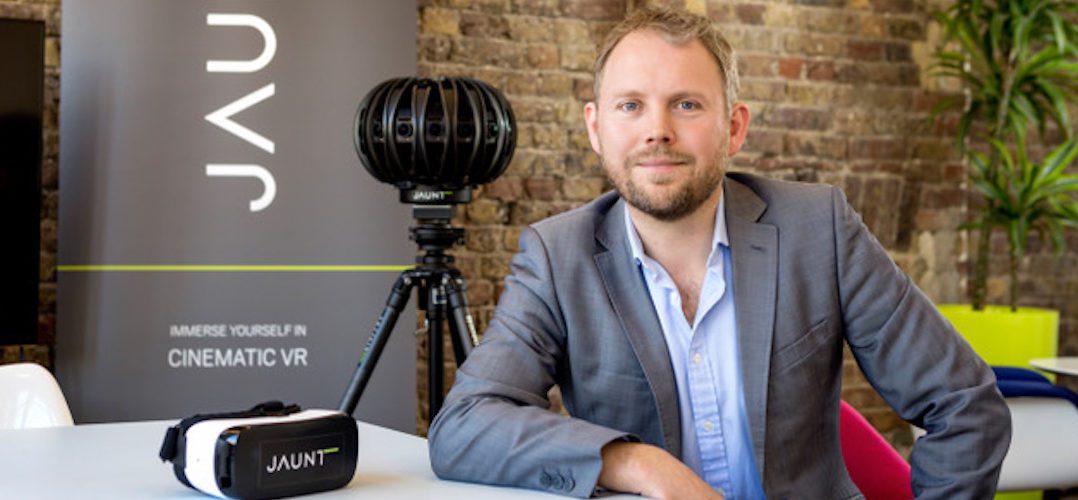This is the third in a series of posts from leading VR and AR influencers in the run-up to MIPTV 2017. The posts are coordinated by VAST MEDIA, a Berlin-based media consultancy.
MIPBlog: Could you please introduce yourself and tell us what brought you into the VR/AR/immersive space?
Dominic Collins: I’m the General Manager of Jaunt VR for EMEA, based out of London and Amsterdam. Jaunt is pioneering the future of creative storytelling through cinematic virtual reality. Founded in 2013, Jaunt is the leading developer of the hardware, software, tools, and applications to enable cinematic VR and put the power of virtual reality in the hands of today’s best content creators. Jaunt works with leading creatives – from brands to artists to filmmakers – to create cutting-edge content accessible across all devices and platforms.
> What are the biggest challenges VR producers and content creators are currently facing?
I think the biggest challenge is also the biggest opportunity, and that’s the fact that in almost everything we do we are inventing and breaking new ground, both creatively and technically. We have collaborated with some of the best creative people and companies to explore storytelling in 360 and VR, from directors like Doug Liman and Tony Kaye to partners like the Walt Disney Company and the Royal Opera House. Simplistically, it starts with the fact that there’s no “behind the camera” and the complexity then seeps into every aspect of our business. It’s a challenge but exciting to be a part of a new way of doing something that sits at the heart of humanity, telling stories.
> How easy or difficult is it currently to sell immersive content? Do VR/AR entertainment companies have dedicated buyers yet?
VR as an entertainment industry is certainly in its infancy. At Jaunt we talk about being a four year old company in a two year old industry! That said there is a broad range of different companies who have recognized that great content can help them meet their business goals and that VR offers a new level of immersion and engagement with the viewer. Whether your selling your brand, products, technology and phones, data, content subscriptions, media or something else, these companies are increasingly experimenting with creating VR and 360 content to engage consumers and differentiate themselves against their competition.
> Could you share some of the key learnings from your own VR projects?
- Right now there is significant distribution to be had by leveraging the quality and immersion of the VR platforms (Oculus, Playstation VR, HTC Vive, Samsung Gear VR, Google Daydream etc.) with the reach of social 360 video (Facebook and YouTube). Make sure you work with a partner that can give you this breadth and you’ll get the most value.
- You can’t expect to stick a VR camera in an “interesting” spot and get an interesting film. You need narrative, good pre-production planning and a real reason to be creating in 360 VR rather than standard 16:9 film.
- Sound is half the experience to creating a real sense of being transported to a virtual reality. We work hard on the binaural audio production, even using Dolby Atmos, to really place the viewer in the scene and bring the experience to life.
> What are the three most impressive VR/AR/immersive productions you have seen recently and why?
- Firstly a VR experience not from Jaunt – this week I saw a new VR film for BeefeaterXO. Whilst it took a while to load, the experience itself was brave, creative and genuinely new, especially as a piece of branded content. I think VR works best when it takes you to places you otherwise could never visit – in this instance, into the imagination of Dabiz Muñoz.
- On the Jaunt side, we have over 160 films on our platform now, but a personal favourite is the Pure McCartney series that we produced last year. We filmed Sir Paul in his personal rehearsal space at home, so it felt very intimate and genuine. We then got Tony Kaye to direct who brought an amazing creativity and invention to the different experiences.
- On AR, I have to choose Microsoft Hololens, not least because it’s real, you can buy one and there are already many people and companies developing and experimenting with the platform. This is clearly the beginning of a long and exciting journey for head mounted AR, but the promise is already there and Google’s project Tango is adding an interesting competitive edge and a mobile first angle.
> Some may fear VR is the new 3D, i.e. that it will never catch on for widespread domestic use. Why do you think it’s here to stay?
I always felt that the difference in experience between 3D and 2D video wasn’t enough to change user behaviour. Also in reality hardly anything actually gets made natively in 3D, it is all converted in post so you never really get a true Wow experience apart from in a few “manufactured” scenes. VR is a whole new experience. I have watched literally thousands of people experience being transported by VR for the first time and their reaction always makes me smile. It is a physical and delightful experience to be immersed into a story and place. What we need to accelerate the industry and people’s consumption is more great content, which is at the heart of our mission at Jaunt.




